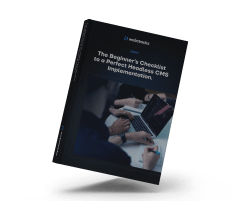You’re in the B2B SaaS space, and you know content marketing can drive growth. But where do you start? How do you create a strategy that actually works?
You need a clear plan to guide your efforts. Here’s how to develop a B2B SaaS content strategy that aligns with your goals and resonates with your audience.
Let’s break it down step by step.

Developing a B2B SaaS Content Strategy: Key Elements
Feeling overwhelmed by where to begin with your content marketing strategy? You're not alone. Many marketing managers grapple with the same challenge.
Unique Value Proposition
First, define your unique value proposition. What sets your SaaS product apart from competitors? Identify the core benefits and features that make your product unique. This clarity helps you communicate effectively with your audience. Consistent messaging across all content builds brand recognition and trust.
Target Audience
Next, understand who you’re targeting. Identify the key demographics, pain points, and needs of your ideal customers. Create detailed buyer personas that represent different segments of your audience. These personas guide your content creation, ensuring it addresses specific challenges and interests of your target market. Conducting a thorough B2B competitor analysis can provide valuable insights into your competitors' strategies, helping you refine your target audience.
Customer Journey
Align your content with the customer journey. Identify the stages your customers go through, from awareness to decision-making. Create content that addresses their needs at each stage. For example, use blog posts and educational content for the awareness stage, case studies and product comparisons for the consideration stage, and demos or free trials for the decision stage.
Content Marketing Goals
Set clear, measurable goals for your content marketing efforts. These goals should align with your overall business objectives. Examples include increasing website traffic, generating leads, or boosting customer retention. Use specific metrics to track progress, such as organic search traffic, lead conversion rates, or customer engagement levels.
Keyword and Topic Research
Research relevant keywords and topics that resonate with your audience. Use tools like Google Keyword Planner, Ahrefs, or SEMrush to identify high-volume, low-competition keywords. Focus on topics that address your audience’s pain points and interests. This research ensures your content is discoverable and valuable to your target market. Implementing efficient content workflows can help scale your content production, ensuring your strategy keeps up with your research efforts.
Content and Distribution Plan
Develop a comprehensive content plan that outlines what content you’ll create, when you’ll publish it, and where you’ll distribute it. Include a mix of content types, such as blog posts, videos, infographics, and case studies. Plan your distribution channels, including your website, social media, email newsletters, and third-party platforms. Consistent publishing and strategic distribution maximize your content’s reach and impact. Building a robust content ecosystem is essential for effective planning and distribution.
Top Content Types for B2B SaaS
Worried about which content types will resonate with your audience? Let's explore some options.
Blog Posts and Articles
Blog posts and articles play a significant role in B2B SaaS content marketing. They help you share insights, industry trends, and product updates. Regularly publishing high-quality articles establishes your brand as a thought leader. Focus on topics that address common pain points and provide actionable solutions. Use a mix of long-form and short-form content to keep your audience engaged. Enhancing your B2B blog strategy can significantly improve your content's effectiveness.
Case Studies and Customer Stories
Case studies and customer stories showcase real-world applications of your product. They provide proof of your product’s effectiveness and build trust with potential customers. Highlight specific challenges your customers faced and how your product helped solve them. Include measurable results and quotes from satisfied clients to add credibility.
Webinars and Videos
Webinars and videos offer an engaging way to present complex information. Use webinars to conduct live demonstrations, host Q&A sessions, and share expert insights. Videos can range from product demos and tutorials to customer testimonials and industry interviews. Ensure your videos are concise, informative, and visually appealing to maintain viewer interest.
ebooks, Whitepapers, and Guides
Ebooks, whitepapers, and guides provide in-depth information on specific topics. They are valuable resources for educating your audience and generating leads. Offer these documents as gated content, requiring users to provide their contact information to access them. This approach helps you build a list of qualified leads while delivering valuable content to your audience.
Infographics and Interactive Content
Infographics and interactive content make complex data easy to understand. Use infographics to visualize statistics, processes, and comparisons. Interactive content, such as quizzes, calculators, and assessments, engages users and encourages them to spend more time on your site. Both formats are highly shareable, increasing your content’s reach and visibility.

How to Optimize SaaS Content for SEO
Worried that your content isn't getting noticed? SEO optimization can make a big difference.
On-Page SEO Best Practices
Start with clear, descriptive titles that include your primary keyword. Use header tags (H1, H2, H3) to structure your content, making it easier for search engines to understand. Include your primary keyword in the first 100 words and naturally throughout the content. Use meta descriptions to summarize your content and entice clicks. Optimize images with descriptive file names and alt text. Ensure your URLs are short, descriptive, and include your primary keyword. Internal linking helps distribute page authority and keeps users engaged. Following SaaS website best practices can enhance your on-page SEO and user experience.
Keyword and Linking Strategy
Identify primary and secondary keywords relevant to your audience. Use tools like Google Keyword Planner, Ahrefs, or SEMrush to find keywords with high search volume and low competition. Create a keyword map that aligns with your content plan. Use primary keywords in titles, headers, and meta descriptions. Incorporate secondary keywords naturally throughout the content. Develop a linking strategy that includes internal links to related content and external links to authoritative sources. This boosts your content’s credibility and helps search engines understand its context.
E-A-T Signals
E-A-T stands for Expertise, Authoritativeness, and Trustworthiness. Demonstrate expertise by providing well-researched, accurate content. Authoritativeness comes from being recognized as a leader in your field. Trustworthiness involves transparency and reliability. Include author bios to showcase credentials. Use data, case studies, and references to back up claims. Secure your site with HTTPS and display trust signals like customer testimonials and reviews. Regularly update content to maintain accuracy and relevance.
Technical SEO Considerations
Ensure your site loads quickly. Use tools like Google PageSpeed Insights to identify and fix issues. Optimize for mobile devices, as a significant portion of users access content on smartphones and tablets. Use a responsive design that adapts to different screen sizes. Implement schema markup to help search engines understand your content’s structure. Create an XML sitemap and submit it to search engines to ensure all pages are indexed. Fix broken links and ensure your site has a clean, crawlable structure.
Measure and Analyze Content Performance
Use tools like Google Analytics and Search Console to track content performance. Monitor metrics like organic traffic, bounce rate, and average session duration. Track keyword rankings to see how your content performs in search results. Analyze user behavior to understand how visitors interact with your content. Identify high-performing content and replicate its success. Use A/B testing to experiment with different headlines, images, and calls to action. Regularly review and update your content strategy based on performance data. Implementing new strategies to drive B2B website traffic can provide fresh insights for performance measurement.
Promoting and Distributing SaaS Content
Concerned your content won't reach the right audience? Promotion and distribution are key.
What Are Owned, Earned, and Paid Content Promotion Channels?
Utilize a mix of owned, earned, and paid channels to distribute your content. Owned channels include your website, blog, and email newsletters. These platforms give you full control over your content and how it’s presented. Earned channels involve getting your content shared by others, such as through social media shares, mentions, and backlinks from reputable sites. Paid channels include advertising on platforms like Google Ads, LinkedIn, and sponsored content on industry websites. Combining these channels ensures broad and effective distribution.
How to Leverage Social Media and Email Marketing?
Social media and email marketing are powerful tools for promoting your content. Share your blog posts, articles, and other content on platforms like LinkedIn, Twitter, and Facebook to reach a wider audience. Engage with your followers by responding to comments and participating in discussions. Email marketing allows you to deliver content directly to your subscribers’ inboxes. Segment your email list to send targeted content that resonates with different audience segments. Regular newsletters can keep your audience informed and engaged.
Why Syndicate and Repurpose Content?
Syndicate your content on platforms like Medium, LinkedIn Pulse, and industry-specific websites to reach new audiences. Repurpose your existing content into different formats to extend its lifespan and reach. For example, turn a blog post into an infographic, a video, or a series of social media posts. This approach not only maximizes the value of your content but also caters to different audience preferences.
How to Use Influencer Marketing and Guest Posting?
Collaborate with industry influencers to amplify your content’s reach. Influencers can share your content with their followers, providing credibility and expanding your audience. Identify influencers who align with your brand and have a strong following in your industry. Guest posting on reputable industry blogs and websites is another effective way to reach new audiences. Write high-quality, informative articles that provide value to the host site’s readers, and include links back to your own content. This strategy helps build backlinks and drives traffic to your site.
Emerging Trends in B2B SaaS Content Marketing
Worried about staying ahead of the curve? Let’s dive into some emerging trends.
How Is AI and Automation Changing Content Marketing?
AI and automation have transformed content marketing. AI tools now assist in content creation, from generating blog post ideas to drafting articles. Automation platforms streamline content distribution, ensuring your content reaches the right audience at the right time. Predictive analytics help you understand what content will resonate with your audience, allowing for more targeted and effective marketing strategies. AI-driven chatbots enhance customer interaction, providing instant responses and personalized content recommendations.
Why Shift to Video and Interactive Formats?
Video content continues to dominate. Webinars, product demos, and explainer videos engage audiences more effectively than text alone. Interactive formats like quizzes, polls, and interactive infographics keep users engaged and provide valuable insights into their preferences and behaviors. These formats not only capture attention but also encourage sharing, increasing your content's reach. Live streaming and virtual events offer real-time interaction, fostering a sense of community and immediacy.
What’s the Value of Thought Leadership and Original Research?
Establishing your brand as a thought leader builds trust and authority. Publishing original research, industry reports, and in-depth analyses positions your company as an expert in your field. Thought leadership content attracts high-quality backlinks, improving SEO and driving organic traffic. Collaborate with industry experts to co-author articles or participate in podcasts and webinars. Sharing unique insights and data sets your content apart and provides real value to your audience.
How Does Hyper-Personalization and ABM Work?
Hyper-personalization tailors content to individual user preferences and behaviors. Use data analytics to understand your audience's needs and deliver personalized content experiences. Account-Based Marketing (ABM) focuses on creating customized content for specific high-value accounts. This approach aligns sales and marketing efforts, targeting key decision-makers with content that addresses their unique challenges and goals. Personalized email campaigns, targeted ads, and bespoke content pieces enhance engagement and conversion rates. Developing a global content strategy can help expand your reach and tailor content to diverse audiences.
Is B2B SaaS Content Marketing Worth the Investment?
Investing in B2B SaaS content marketing can yield significant returns. Content marketing drives organic traffic, generates leads, and builds brand authority. The ROI of content marketing for SaaS often surpasses traditional marketing methods. High-quality content attracts and engages potential customers, leading to higher conversion rates. Over time, the cost per lead decreases as your content continues to attract traffic without additional investment.
Building long-term brand authority and generating leads are key benefits. Consistently publishing valuable content positions your brand as a thought leader in your industry. This trust translates into increased customer loyalty and higher lifetime value. Content marketing also fuels lead generation by providing prospects with the information they need to make informed decisions. Educational content, case studies, and whitepapers help nurture leads through the sales funnel.
Consistency and patience are vital. Content marketing is a long-term strategy that requires regular updates and new content. Results may not be immediate, but over time, the cumulative impact of consistent content can be substantial. Patience is necessary to see the full benefits, as search engines take time to index and rank new content.
Deciding between outsourcing and in-house content creation depends on your resources and goals. Outsourcing to a specialized agency can provide expertise and save time. Agencies often have experienced writers, SEO specialists, and content strategists who can deliver high-quality content efficiently. However, in-house teams offer more control and alignment with your brand’s voice and vision. Building an in-house team requires investment in hiring and training but can lead to a more cohesive content strategy.
Ready to elevate your web presence? See the Webstacks difference by scheduling a brief discovery call today. Visit Webstacks to get started.

B2B SaaS Content Marketing FAQs
1. What is B2B SaaS content marketing? B2B SaaS content marketing involves creating and promoting content that educates and engages potential customers about a SaaS product, aiming to increase brand awareness, drive organic traffic, and generate leads.
2. What is content marketing in B2B marketing? Content marketing in B2B marketing focuses on creating valuable, relevant, and consistent content to attract and retain a clearly defined audience, ultimately driving profitable customer actions.
3. What is B2B SaaS market? The B2B SaaS market refers to the industry where businesses provide software solutions as a service to other businesses, often focusing on subscription-based models and cloud-based services.
4. How much does B2B SaaS marketing pay? B2B SaaS marketing salaries can vary widely based on role, experience, and location. For example, a B2B SaaS content marketer might earn between $60,000 to $120,000 annually, depending on their expertise and the company's size.




